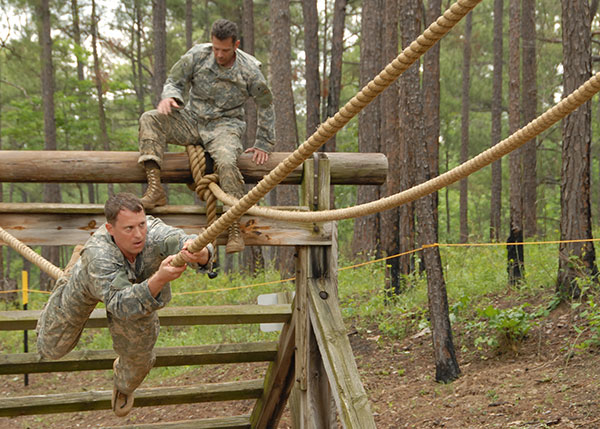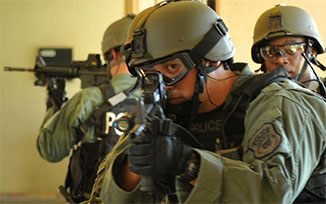Special Forces Selection & Training
The US Army is looking for a certain type of soldier to fill the ranks of its Special Forces. The Special Forces Assessment and Selection (SFAS) and Special Forces Qualification (Q course) courses are accordingly tough and have a high attrition rate. 300 potential Green Berets at a time attend the SFAS course which is held 4 times a year.
Eligibility
Candidates wishing to try out for the Special Forces must meet the following criteria:
(1) Must be an active duty male soldier.
(2) Must be a U.S. citizen (nonwaiverable).
(3) Must be airborne qualified or volunteer for airborne training.
(4) Must be able to swim 50 meters wearing boots and battle dress uniform (BDU) prior to beginning the SFQC. All soldiers will be given a swim assessment at the SFAS Course to determine whether he is a swimmer or nonswimmer.
(5) Must score a minimum of 206 points on the APFT, with no less than 60 points on any event, using the standards for age group 17 to 21.
(6) Must be able to meet medical fitness standards as outlined in AR 40-501.
(7) Must be eligible for a SECRET security clearance.
(8) No solider, regardless of MOS or basic branch will be recruited if he is unable to reclassify from his current MOS or basic branch into CMF 18.
(9) Not currently serving in a restricted MOS or branch.
b. Additional criteria exclusive to enlisted applicants:
(1) Enlisted applicants must be in the pay grade of E-4 to E-7. Successful completion of the
SFAS Course is a prerequisite to the SFQC.
(2) Must be a high school graduate or have a general educational development certificate.
(3) Must have a general technical score of 100 or higher.
(4) Stabilization of current drill sergeants and detailed recruiters will not be broken.
(5) Specialists, corporals, and sergeants that successfully complete the SFAS Course will normally have their retention control points waived to attend the SFQC. Upon successful ompletion of SFQC, they will be allowed continued service. Staff sergeants approaching their retention control points will not be allowed to apply. Sergeants first class must have no more than 12 years TIS and 9 months time in grade when applying for the SFAS Course and they must be either airborne or ranger qualified. Sergeants first class must attend the SFAS Course within 90 days of volunteering and also be able to have a permanent change of station (PCS) to the SFQC within 6 months of selection from the SFAS Course.
(6) Soldiers on assignment will not be allowed to attend the SFAS Course without their branch’s prior approval. Soldiers on orders to a short tour area will be allowed to attend the SFAS Course if a deferment is not required. These individuals will be scheduled for the next available SFQC after their date eligible for return from overseas. Soldiers who volunteer for the SFAS Course prior to receiving assignment notification will be deferred to allow for SFAS Course attendance.
(7) Outside continental United States based soldiers may attend the SFAS Course in a temporary duty (TDY) and return status anytime during their tour. Upon successful completion of the SFAS Course, soldiers will be scheduled for the next available SFQC provided they have completed at least two-thirds of their overseas assignment obligation and have received approval from the United States Total Army Personnel Command (PERSCOM) for curtailment of the remainder of their overseas tour obligation. Soldiers serving on a short tour will not have their assignment curtailed.
(8) Continental United States based soldiers may attend the SFAS Course in a TDY and return status anytime during their tour. Upon successful completion of SFAS, soldiers will be scheduled to attend SFQC ensuring that they will have completed at least 1 year time on station prior to PCS.
(9) Must have a minimum of 24 months remaining TIS upon completion of the SFQC.
c. Additional criteria exclusive to officer applicants:
(1) Have at least a SECRET security clearance prior to final packet approval and meet eligibility
criteria for a TOP SECRET clearance.
(2) Have completed the Officer Basic Course and have been successful in your branch assignments
prior to application for SF.
(3) Have a Defense Language Aptitude Battery (DLAB) score of 85 or higher (or a Defense
Language Proficiency Test (DLPT) of a minimum of 1/1 reading and listening score).
(4) Have a minimum of 36 months remaining TIS upon completion of SFDOQC.
d. All applicants must not:
(1) Be barred to reenlistment or be under suspension of favorable personnel action.
(2) Have been convicted by court-martial or have disciplinary action noted in their official military personnel fiche under the provisions of the Uniform Code of Military Justice (Article 15). This provision can only be waived by the Commanding General, United States Army John F. Kennedy Special Warfare Center and School (USAJFKSWCS) on a case-by-case basis.
(3) Have been terminated from SF, ranger, or airborne duty, unless termination was due to
extreme family problems or a medical condition that has been resolved.
(4) Have 30 days or more lost time under United States Code 972 within current or preceding
enlistment..
Special Forces Assessment and Selection (SFAS)
The 24 day Special Forces Assessment and Selection course is run out of the Col. mick Rowe Special Forces Training Facility at Camp MacKall, North Carolina. The SFAS is designed to select candidates suitable for the Special Forces Qualification course and such is structures to push the candidates to their limits of physical and mental endurance. Typical elements of the SFAS include:
- Marches of various length or duration, day, night, all weathers and all while carrying 50lb backpacks. Candidates are not told at the beginning of a march how long it will last.
- Runs, with or without packs
- Obstacle courses - designed to test fitness, stamina but also to weed out candidates with a fear of heights or enclose spaces
- Orientation and Fieldcraft Exercises test the potential Green Beret's ability to navigate with map and compass.
- Situation and Reaction Exercises - tests designed to evaluate the Special Forces candidate's ability to solve problems while mentally and physically exhausted.
- Team Cooperation Exercises test the candidates' ability to work together and accomplish a common goal. Being able to work as a part of a team while under pressure is an important attribute of a Special Forces soldier.
SFAS Overview
| Day 1-3 | Day 4-19 | Day 20-22 | Day 23-24 |
|
|
|
|
Throughout the Special Forces Assessment and Selection course the candidates are purposefully deprived of sleep and kept under pressure. By the time the SFAS course is in its second week over half of the original 300 candidates will have either given up or been bounced by the instructors. Those who remain after the 24-day SFAS course is over can now look forward to the grueling Special Forces Qualification course, also known as the Q course. (see below)

Special Forces Qualification Course (SFQC)
Soldiers who make it through the SFAS course move on to the Special Forces Qualification Course (SFQC). Once a soldier completes the 'Q course', they enter the Special Forces brotherhood and earn the right to wear the Special Forces tab and Green Beret.
Course description : the SFQC consists of 6 sequential stages of training:
Course Orientation & History PHASE 1: 7 Weeks
|
Language and Culture PHASE II: 18-25 Weeks
|
Small Unit Tactics (SUT) PHASE III: 13 Weeks
|
MOS Training PHASE IV: 14-50 Weeks
|
UW Culex (Robin Sage) PHASE V: 4 Weeks
|
Graduation PHASE VI: 1 Week
|
Official US Army video on Special Forces Qualification Course...
Further Special Forces Training
After SFQC, Green Berets are assigned to a position in a Special Forces Group and go on to further training.
more info : Special Forces Training





